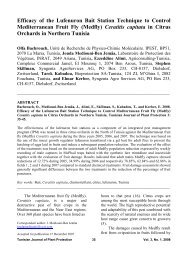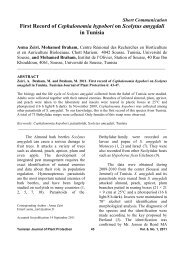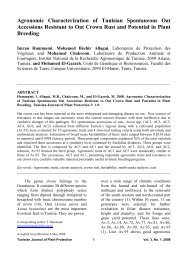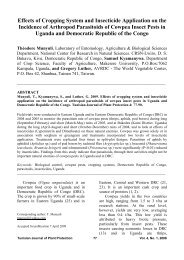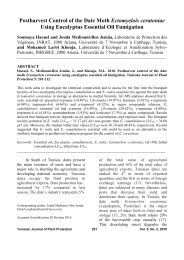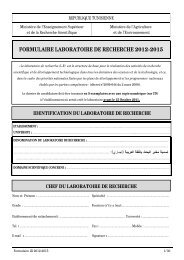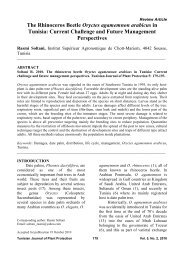Tunisia - Iresa
Tunisia - Iresa
Tunisia - Iresa
You also want an ePaper? Increase the reach of your titles
YUMPU automatically turns print PDFs into web optimized ePapers that Google loves.
Table 2. Frequency of the chemical treatments<br />
in citrus orchards (Cap-Bon and Bizerte<br />
regions, <strong>Tunisia</strong>) made from 25 March to 29<br />
April 2010<br />
Chemical treatments Scarred fruits<br />
(number / year)<br />
4 - 7<br />
9 - 14<br />
16 - 21<br />
25 – 30<br />
(%)<br />
46.37<br />
57.26<br />
60.26<br />
65.52<br />
DISCUSSION<br />
This work on citrus thrips in<br />
<strong>Tunisia</strong> has lead to two results: a<br />
preliminary composition of the species<br />
living on citrus trees and a global<br />
estimation of the proportion of fruits<br />
damaged either by thrips or other factors<br />
causing nearly the same symptoms.<br />
The inventory of thrips in 7 citrus<br />
orchards, in which the proportion of<br />
scarred fruits were high, showed a varied<br />
fauna composed by 10 genus and 13<br />
species, 12 of them are plant feedings and<br />
one is predator. As compared to findings<br />
from other countries, the biodiversity of<br />
thrips species in citrus orchards is lower.<br />
Indeed, often more than 40 thrips species<br />
have been identified in association with<br />
citrus in the world (13). In Florida, for<br />
example, the inventory of thrips species<br />
in 7 citrus orchards showed 36 species<br />
among which 7 are predatory, 21 are<br />
phytophagous and 8 are mycophagous<br />
(8). Our results expressing a relatively<br />
low biodiversity can be explained by the<br />
high number of chemical treatments<br />
applied in the sampled orchards (in<br />
average 16 treatments/year). The forty<br />
species found in Florida were from<br />
orchards with reduced to no pesticide<br />
spray programs. Moreover, the short<br />
period of the sampling (from 25 March to<br />
29 April 2010) could explain the low<br />
number of collected thrips species. For<br />
instance, in Florida, the 36 species<br />
identified were found after a sampling<br />
monthly for thrips over 13 months in 7<br />
citrus orchards (8). Furthermore, in our<br />
work, thrips were collected mainly from<br />
citrus trees, while the cover ground plants<br />
on which can live most citrus thrips<br />
species, have not been regularly sampled.<br />
Among the thrips species<br />
identified, P. kellyanus, the most<br />
economically important species, was<br />
found to be the less frequent as it was<br />
noted only in the region of Bizerte in one<br />
orchard on three in the locality<br />
of Azib on Meski oranges.<br />
The other few widespread species<br />
that have been reported only in Cap-Bon<br />
and in one or two on four orchards are: A.<br />
citricinctus, T. major, T. tabaci, T.<br />
angusticeps and S. graminum. All these<br />
species were found only on Valencia late<br />
oranges.<br />
The onion thrips, T. tabaci have<br />
a broad host range including citrus genus<br />
but is not reported as a typical pest<br />
of citrus (26). The species T. major is<br />
also polyphagous but has been<br />
reported only once as a damaging pest<br />
of citrus in North Africa (6). The species<br />
T. angusticeps, rather associated with<br />
cereals and leguminous crops, has been<br />
reported also on citrus in Turkey and<br />
Spain but its status as pest of citrus has<br />
not been confirmed yet (26). The thrips<br />
S. graminum which is normally<br />
associated with grasses (12) was also<br />
found on citrus but is not reported as a<br />
pest of this crop (20). The thrips<br />
Aeolothrips which colonizes herbaceous<br />
plants, shrubs and trees in countries<br />
of Europe and North Africa appears to be<br />
a facultative predator (12).<br />
The most widespread species<br />
found in both regions of Cap-Bon and<br />
<strong>Tunisia</strong>n Journal of Plant Protection 48 Vol. 7, No. 1, 2012






